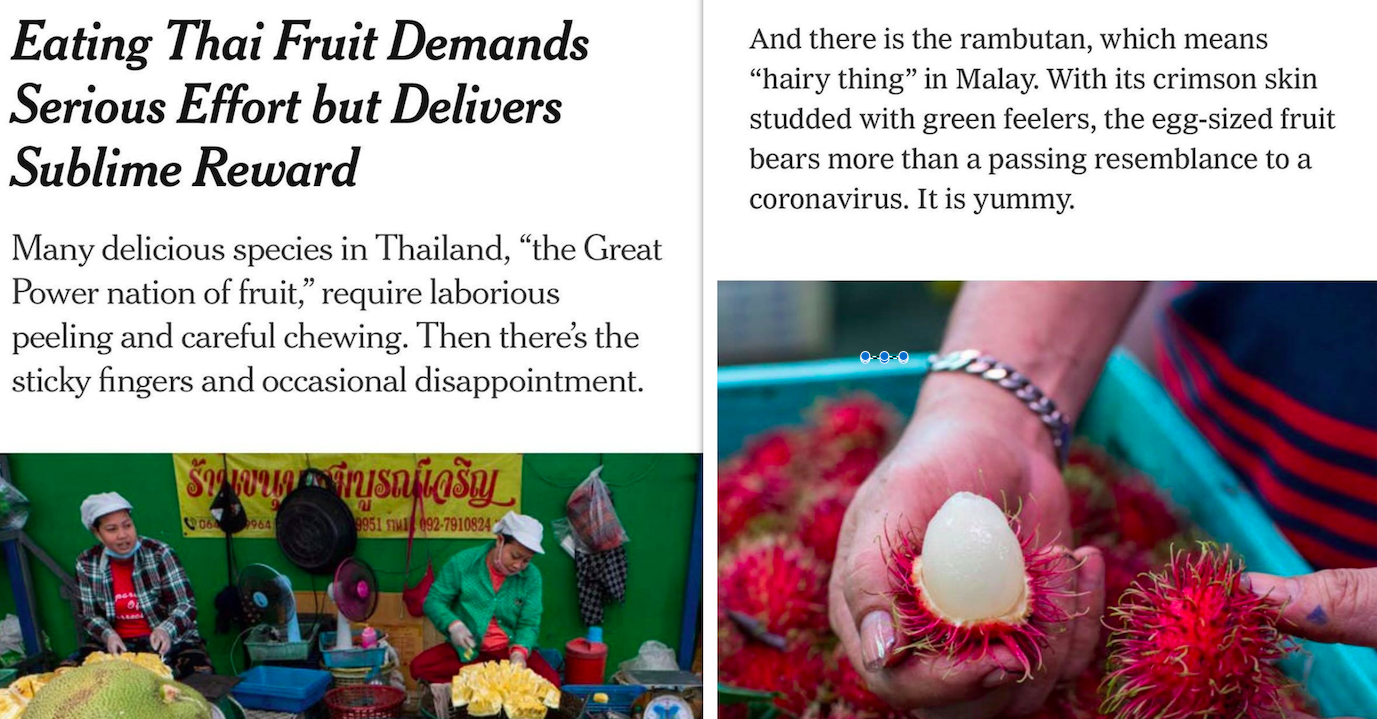"Exotic" Southeast Asian fruits have once again come under the scrutiny of western media — New York Times, to be specific.
This time, it's not just durians, but the whole gamut: Rambutans, mangosteens, dragon fruits, and more are implicated.
The article, titled "Eating Thai Fruit Demands Serious Effort but Delivers Sublime Reward," was published on June 22, 2020.
It is an interesting lens to look through for those acquainted with the fruits, almost akin to seeing them from an alien point of view.
Some might find their hackles raised, though, as certain phrases in the article are susceptible to accusations of orientalism.
Here are the extracts for each fruit:
Rambutan
"With its crimson skin studded with green feelers, the egg-sized fruit bears more than a passing resemblance to a coronavirus. It is yummy."
Langsat (duku)
"To snack during office hours on a langsat, a demure cousin of a lychee with a peel that oozes a kind of natural super glue, is to submit to sticky fingers and sticky keyboards. Soap doesn’t help.
The meat is perfumed but each bite is fraught, lest teeth accidentally penetrate the bitter seeds. The langsat is worth it, but only just."
Jackfruit
"Unlike a banana’s easy extraction, dissecting a jackfruit is to hack through a jagged sheath, then painstakingly pluck out rubbery polyps that taste like overripe Juicy Fruit gum."
Dragon fruit
"In terms of showiness, the rambutan jousts with the dragon fruit, a neon pink mini-football covered in acid-green tendrils. To some, the experience of eating a dragon fruit, which grows on a cactus indigenous to South America, is a letdown after all that dazzling packaging: It’s a bland mush with tiny seeds that can require floss to dislodge."
Guava
"Thais tend to approach milder fruit as a canvas for the fermented, spicy flavors that dominate the country’s cuisine. So guavas, rose apples and pomelos, the world’s largest citrus, are often served with a chili, salt and sugar dip to enliven the experience."
Mangosteen
"If someone’s fingernails are dyed purple at the tips, it likely betrays a preference for the mangosteen, a palm-sized orb that looks like an extra in a Super Mario Bros. video game. Beneath its woody rind are juicy segments that strike a Socratic equilibrium between sweet and sour.
Even a peach has nothing on a mangosteen when it is perfect, but the mangosteen is rarely perfect. Many are afflicted with a blight that tarnishes the white flesh an ugly mustard hue. Which fruit is blemished is unknowable before peeling, and so to eat a pile of mangosteens is an exercise in disappointment."
Salak (snake fruit)
"Inside is a not-quite-crunchy flesh that, like so many of Southeast Asia’s native fruits, hovers between delectable and decayed."
Durian
"There is a fruit encased in prickly armor that smells of a deep, dank rot.
[...]
On the outside, the durian resembles a medieval torture device. Nestled inside the spiky shell are kidney-shaped lobes of custard. The flavor is somewhere between an off-peak Gorgonzola and a crème caramel, with a whiff of skunk."
Twitter outrage
While some may remain unperturbed by the descriptions, the article has sparked no small amount of outrage on Twitter.
https://twitter.com/KhushAndOJ/status/1275425719175315456
https://twitter.com/susanmini/status/1275484490568069121
https://twitter.com/osayiendolyn/status/1275850033108267008
was unable to make clear that these are likely her personal preferences. I'm not a fan of durian either, but it certainly did not "stink" of anything when I ate it at a durian farm, it was enjoyable! We have a role to play in parsing culture for others (2/x)
— Janice Leung Hayes (@e_ting) June 24, 2020
I swear, every article I read in the New York Times convinces me anew that the whole institution is a waste of space at this point
— i, too, overflow (@iwishiwasafinch) June 23, 2020
This example of old-school worldly dispatch reported as a magazine-style feature immediately makes it extremely clear it only wants to paint the story's setting in ~*~exotic~*~ terms: Tropical Sun, Sticky Sweet Fruit, Peculiar Cultural Habits Of These Strange Peoples. pic.twitter.com/RRE5K2qZur
— Amirul Ruslan (@amirulruslan) June 25, 2020
Writing about US food the way the NYT covers Asian fruit: In a nation torn by racial conflict, one unlikely food unites. To those accustomed to chopsticks, the greasy parcel known as a 'burger', a sort of split bao, is crude and messy. Yet it encapsulates a nation's violent past.
— Soon-Tzu Speechley 孫子 (@speechleyish) June 25, 2020
In fact, there was enough traction that Bangkok Herald reported on it.
Bangkok Herald, however, was not in approval of the critics, and labelled them as "humourless, self-anointed Thai culture experts."
Half-Japanese writer
According to her New York Times profile, Hannah Beech, the writer of the article, is half-Japanese and half-American.
Beech was named journalist of the year by the Society of Publishers in Asia in 2011, and has interviewed prominent Asian leaders like Shinzo Abe and Joko Widodo.
She lives in Bangkok.
H/T: @jemmawei on Instagram
Top image via New York Times
If you like what you read, follow us on Facebook, Instagram, Twitter and Telegram to get the latest updates.
